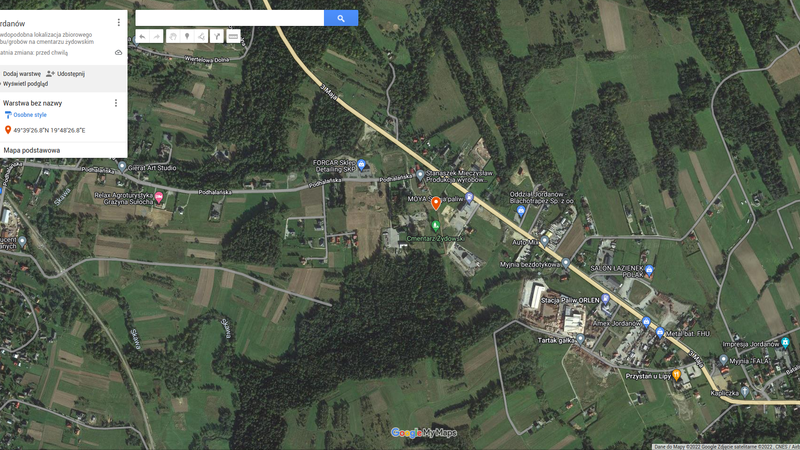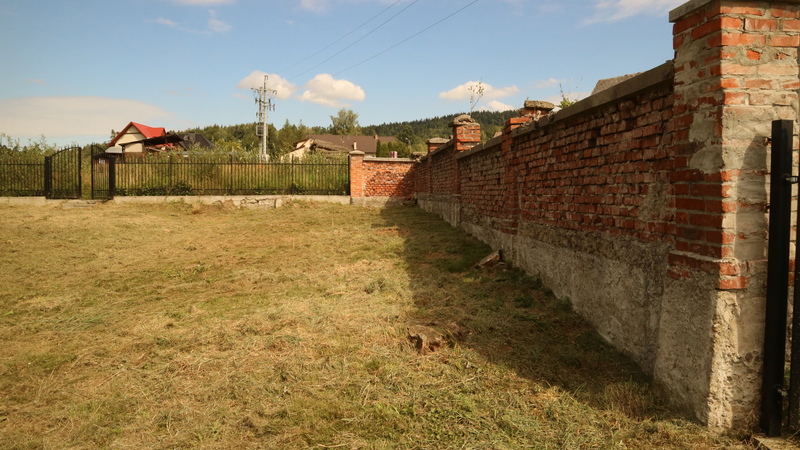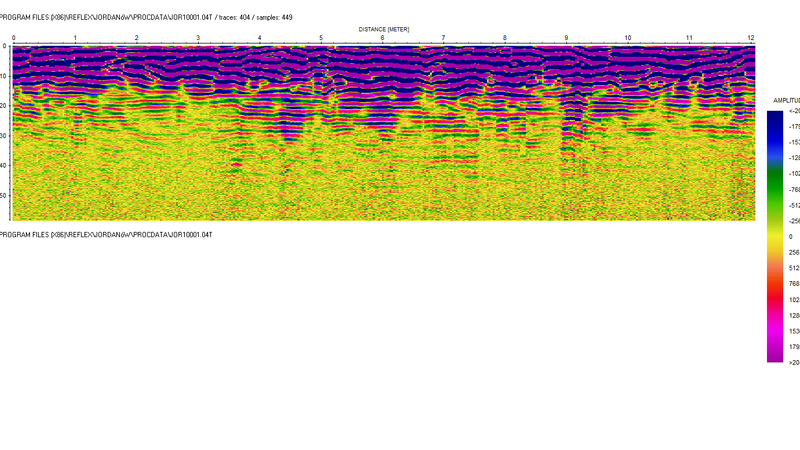Jordanów
Borough of Jordanów , Suski District, Małopolskie VoivodshipType of place
The Jewish cemetery in Jordanów and the meadow near “Zakręty” in Jordanów.Information about the crime
Grzegorz Miśkiewicz, a local historian, informed us about the Jewish graves in Jordanów. He has been researching the history of Jordanian Jews for years. He included his vast knowledge and the effect of many years of research in two books published in 2015 and 2022. The following text is based on these books and Miśkiewicz’s notes.
The largest massacre of Jews in Jordanów took place on August 29, 1942, on the day of deportation of all Jews to Rabka, where they were loaded onto trains and transported to the death camp in Bełżec. “However, not everyone was in this group. On the same day, near Zakręty in Jordanów, the Germans executed about 70 people, mainly the elderly, women and children”. (Miśkiewicz, 2015)
Several people saw the execution and the Jews being led to death.
“The Jews were lined up in the meadow, right next to the grave with a plank above it. One by one people climbed onto the plank, were shot and fell into the grave. They were still alive, their bodies trembling in agonizing pain, as they were covered with lime. (Stanisław Targosz cit.: Miśkiewicz 2015)
“The Jews were ordered to dig a huge grave (on the right, behind the bridge on “Zakrety”). Old people, women and children were gathered there, and then the execution began. A Polish policeman, Emil Wilczek, also took part in it. Shot Jews fell into the dug grave. After the execution, the Polish population was brought to the crime scene. They were ordered to carry the remaining bodies to the grave and cover them with lime. A Jewish woman named Gramonova miraculously dodged the bullet as she stood with a child in her arms among those awaiting death. As the shots were fired, the bullet hit the baby. The mother fainted, and the corpses of the shot people crushed her. When she was pulled out from under several dead people, she regained consciousness and began to ask for her life. The supervising Gestapo officer did not want to shoot. He walked away, pretending he didn’t see the woman. Wilczek noticed his hesitation, took out a pistol, approached the woman and fired. It was Saturday. When I went to the church in Jordanów on Sunday, I saw a meadow covered with blood. The grave was still moving”. (Stanisław Kościelniak, cit.: Miśkiewicz 20215)
The bodies of the Jews murdered in the meadow in August 1942 were probably dug up in the late 1940s and moved to the Jewish cemetery in Jordanów. The place of the grave has not been marked or commemorated in any way.
Grzegorz Miśkiewicz posted the following text on the web:
“After the war, the bodies were exhumed and moved to the nearby Jewish cemetery [in Jordanów]. They were buried in a hastily dug grave, or rather a large pit, in the middle of the cemetery path. Witnesses to this “burial” are still alive today. When you enter the cemetery through the main entrance, you can see a slightly sunken area, overgrown with wildflowers”. (sztetl.org.pl)
The Jewish cemetery in Jordanów was a place of torture and burial of victims of many individual and mass executions. According to Grzegorz Miśkiewicz, at least three unmarked graves of Holocaust victims may be located in the Jewish cemetery in Jordanów.
“Maria Rychlik describes her shocking memories in her 1967 book “Śmierć daje życie”. She owned a house and a brickyard located next to the Jewish cemetery. For this reason, she became an eyewitness to many murders committed there by the Germans. The first one she mentions took place in January 1942. Two families were brought to the cemetery. They were told to undress in minus twelve degrees Celsius weather. That was the way to extort money from them. When the children began to cry, they were all ordered to dance to warm up. Then they were beaten to death. Maria Rychlik points out that there were many similar events. Almost every day she saw the victims dragging their last strength just before their deaths inflicted by their torturers. She also witnessed the death of her friends, the Sternberg family, whom she buried herself. “I saw a terrible sight. There were six people here, lying quietly, the father holding two small children in his arms. One of them was still alive, still moving, all covered in blood. They had all been shot in the head and were lying together, holding each other. Only the mother lay apart. She was beaten and shot in the chest. She looked like she was fighting a murderer. It was a terrible sight. The mere memory makes my blood run cold. For a long time after this incident, I could not eat or sleep. I never went to the cemetery after that”. (Miśkiewicz, 2022)
The action during which all Jews were herded to the market square in Jordanów was also not without fatalities. Older people, the sick or those who panicked, were problematic for the perpetrators. In such cases, they preferred to get rid of the “problem” right away.
Ozjasz Schechner, a Holocaust survivor, escaped to the forest on the day of the deportation, i.e. August 29, 1942. “The Germans surrounded the market square in Jordanów and started shooting. Among others, the rabbi from Kępno and his family died. Schechner claims that people were killed until 8 pm. […] Then he hid in the brickyard of the Rychlik family, near the Jewish cemetery. He was an eyewitness to the murders of the Sternberg, Korn and other families committed by Emil Wilczak. Schechner writes that people were rounded up every day, brought to the cemetery and murdered”. (AŻIH 301/3453 cit.: Miśkiewicz, 2015)
IDENTIFICATION OF THE GRAVE BASED ON NON INVASIVE RESEARCH
On August 9, 2022, a site inspection was carried out at the Jewish cemetery in Jordanów in order to locate mass graves. A location was selected in the north-eastern corner of the Jewish cemetery, between the currently closed mortuary and the eastern section of the cemetery wall (GPS: N 49°39’26.8” E 019°48’26.8”).
Changes in vegetation in the selected area are clearly visible on satellite photographs.
During the site inspection, GPR surveys were carried out. We obtained 10 profiles (echograms) named JOR10001-JOR10010.JOR10001-JOR10006 – profiles collected parallel to the wall, JOR10007-JOR10010 – profiles gathered perpendicularly to the wall. Intrusions (anomalies) were recorded on GPR profiles to a depth of approx. 0.70-1.00 m below ground level. Deeper anomalies are visible on the JOR10004 – JOR10006 profiles at a depth of approx. 4 m and 11.2 m. Presumably, there are hard objects in these places. The anomalies are vertical with relatively even edges. With a high probability, these are objects used in the construction of the cemetery (remnants of matzevot or other hard materials). On the JOR10009 profile, at a depth of 0.1 m to. 2.2 m there is a visible lowering of soil disturbance. Perhaps there is a mass grave site. Clear soil disturbances on profiles JOR10001 – JOR10004 may indicate a mass grave in this area of the cemetery. Presumably, these are two graves with dimensions: length approx. 10 m, width approx. 2.0 m. Depth of soil disturbances: approx. 0.8 m – 1.0 m below ground level.
As a result of the aerial photography query, 2 photos were obtained with the reference numbers: GX12337 SK frame 62 (1945) scale 1:49000 and TUGX 913 SK frame 389 (1944) scale 1:40000. The aerial photograph from 1944 in the scale of 1:40,000, after framing the area of the cemetery, is characterized by low resolution, which makes precise interpretation difficult. The picture shows the boundaries of the cemetery, the mortuary building and the gravestones. The wall of the cemetery casts a shadow on the area subjected to the GPR survey, which makes interpretation impossible. The aerial photograph from 1945, scale 1:45,000, was taken in winter. Snow covering the ground makes precise interpretation impossible.
The LiDAR survey results are inconclusive due to the topographic diversity.
 Jordanów fotografia satelitarna 1a
Jordanów fotografia satelitarna 1a Jordanów fotografia 1 lokalizacji
Jordanów fotografia 1 lokalizacji Jordanów JOR10001
Jordanów JOR10001Contact and cooperation
We are still looking for information on the identity of the victims and the location of Jewish graves in Jordanów. If you know something more, write to us at the following address: fundacjazapomniane@gmail.com.
Bibliography
Miśkiewicz G. “Życie i zagłada izraelickiej gminy wyznaniowej w Jordanowie”, 2015
Miśkiewicz G. “Milczeli czekając na śmierć. Zagłada jordanowskich Żydów w świetle akt śledztw przeprowadzonych w latach 1973-2016 oraz innych dokumentów”, 2022
The materials for this website were developed, digitized and made available as part of the project “Development of a digital archive of Jewish war graves outside the extermination camps and educational use of archive resources”, thanks to funding from the Minister of Culture and National Heritage from the Cultural Promotion Fund.
